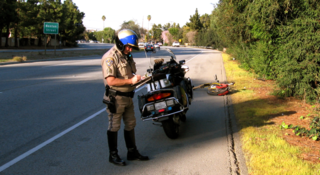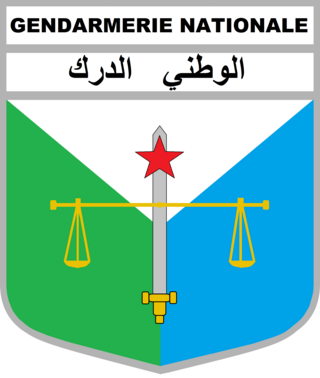
Military police (MP) are law enforcement agencies connected with, or part of, the military of a state. In wartime operations, the military police may support the main fighting force with force protection, convoy security, screening, rear reconnaissance, logistic traffic management, counterinsurgency, and detainee handling.

A highway patrol is a police unit, detail, or law enforcement agency created primarily for the purpose of overseeing and enforcing traffic safety compliance on roads and highways within a jurisdiction. They are also referred to in many countries as traffic police, although in other countries this term is more commonly used to refer to foot officers on point duty who control traffic at junctions.

A gendarmerie is a military force with law enforcement duties among the civilian population. The term gendarme is derived from the medieval French expression gens d'armes, which translates to "men-at-arms". In France and some Francophone nations, the gendarmerie is a branch of the armed forces that is responsible for internal security in parts of the territory, with additional duties as military police for the armed forces. It was introduced to several other Western European countries during the Napoleonic conquests. In the mid-twentieth century, a number of former French mandates and colonial possessions adopted a gendarmerie after independence. A similar concept exists in Eastern Europe in the form of Internal Troops, which are present in many countries of the former Soviet Union and its former allied countries.

The Austro-Hungarian Army, also known as the Imperial and Royal Army, was the principal ground force of Austria-Hungary from 1867 to 1918. It consisted of three organisations: the Common Army, the Imperial-Royal Landwehr and the Royal Hungarian Honvéd.

The National Gendarmerie is one of two national law enforcement forces of France, along with the National Police. The Gendarmerie is a branch of the French Armed Forces placed under the jurisdiction of the Ministry of the Interior, with additional duties from the Ministry of Armed Forces. Its responsibilities include policing smaller towns, suburbs and rural areas, crowd and riot control, criminal investigation, including cybercrime. By contrast, the National Police is a civilian law enforcement agency that is in charge of policing cities and larger towns. Because of its military status, the Gendarmerie also fulfills a range of military and defence missions. The Gendarmerie has a strength of around 102,269 people.

Provosts are military police (MP) whose duties are policing solely within the armed forces of a country, as opposed to gendarmerie duties in the civilian population. However, many countries use their gendarmerie for provost duties.

Law enforcement in Austria is the responsibility of the Directorate General for Public Security, a subdivision of the Federal Ministry of the Interior located at Herrengasse 7 in Vienna. Over 20,000 police officers are on duty in the Federal Police at more than 1,000 police stations. On lakes and rivers the federal police has over 70 boats and other craft to act as the water police.

In many countries, particularly those with a federal system of government, there may be several law enforcement agencies, police or police-like organizations, each serving different levels of government and enforcing different subsets of the applicable law.

The Imperial and Royal Minister of War, until 1911: Reich Minister of War, was the head of one of the three common ministries shared by the two states which made up the dual monarchy of Austria-Hungary from its creation in the Compromise of 1867 until its dissolution in 1918.

The Ministry of Finance is the government ministry of Austria responsible for the collection of taxes and customs as well as the administration of fiscal and economic policy. It oversees the Revenue Service, the Revenue Service for Large Businesses, the Financial Police, and various other agencies.

The Common Army as it was officially designated by the Imperial and Royal Military Administration, was the largest part of the Austro-Hungarian land forces from 1867 to 1914, the other two elements being the Imperial-Royal Landwehr and the Royal Hungarian Honvéd. However, it was simply known as the Army (Heer) by the Emperor and in peacetime laws, and, after 1918, colloquially called the k.u.k. Armee.

The Imperial-Royal Landwehr, also called the Austrian Landwehr, was the territorial army of the Cisleithanian or Austrian half of the Austro-Hungarian Empire from 1869 to 1918. Its counterpart was the Royal Hungarian Landwehr. The two Landwehrs, together with the Common Army and the Imperial and Royal Navy, made up the armed forces of Austria-Hungary. While the name, "Imperial-Royal", might seem to suggest a link between the "Imperial" (Cisleithanian) and "Royal" halves of the Empire, in this context "Royal" actually refers to the Kingdom of Bohemia - not a sovereign kingdom on par with the Kingdom of Hungary, but a crownland of Cisleithanian Austria-Hungary and possession of the Habsburgs, who remained formally entitled to kingship. In this sense, the Kingdom of Bohemia was comparable in status to the Kingdom of Galicia and Lodomeria and the Kingdom of Dalmatia.

The Imperial-Royal Mountain Troops were founded in 1906 as part of the Austrian Landwehr, the territorial army of the Cisleithanian half of the Austro-Hungarian Empire. As a result, the abbreviation "k.k." was used and not "k.u.k." which would have implied a connexion with the Hungarian half of the Empire.
The Directorate General for Public Security is the governing body of general law enforcement in Austria and a division of the Ministry of the Interior. It oversees the Federal Police, the Criminal Intelligence Service, the Intelligence Directorate, the EKO Cobra, and the Aerial Police.

The Djibouti National Gendarmerie is the national Gendarmerie force of Djibouti, tasked with high-risk and specialized law enforcement duties. It is one of the two main police forces in Djibouti, both having jurisdiction over the civilian population. It is a branch of the Djiboutian Armed Forces placed under the jurisdiction of the Ministry of the Interior—with additional duties to the Ministry of Defense. Its area of responsibility includes smaller towns, rural and suburban areas.

The National Guard Forces Command of the Russian Federation is the operational gendarmerie component of the National Guard of Russia, created through a presidential decree on April 5, 2016. Functionally, it is a gendarmerie organized along paramilitary lines with a mission to ensure public order, national security and defense against terrorism. To this end, Forces Command handles the operational units of the National Guard, including its rapid deployment branch, the Separate Operational Purpose Division (ODON); and its naval branch, the National Guard Naval Service Corps.

Ludwig Goiginger was an Austro-Hungarian Lieutenant Field Marshal who notably served in World War I.

The Gendarmerie in the First Czechoslovak Republic was a paramilitary force responsible for law enforcement in rural areas, as well as anti-riot and counterinsurgency duties.


















